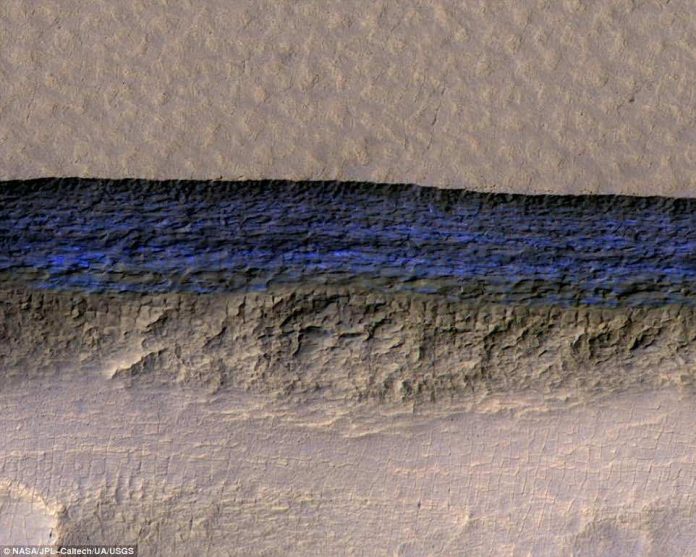Researchers have spotted the most accessible and pure chunks of ice yet on the red planet. They could one day provide life support and fuel for human missions.
In a new paper, researchers argue these findings suggest there are vast stores of underground ice tantalizingly close to the surface, even at low martial latitudes (i.e. closer to the equator). Such reserves could help researchers tease out the planet’s history, and dramatically improve the feasibility of any potential colonies on Mars.
Rust and ice
“This kind of ice is more widespread than previously thought,” says Colin Dundas, a geologist at the U.S. Geological Survey in Flagstaff, Arizona.
We’ve found ice on Mars before. There’s a thick cover of it on the planet’s poles (which Elon Musk thinks we should nuke) and MRO’s radar suite has picked up signatures of buried ice across Mars. Some have argued that those deposits are the remains of ancient glaciers, a by-gone of an age when the planet had a very different climate. However, based on MRO’s radar data, we can’t tell how deep these icy formations are, and whether they’re made up of solid chunks or tiny drops frozen in the soil’s pores.
MRO brought us even more evidence of ice on Mars in the past: pools of (what appears to be) pure ice, puddled on the floors of fresh meteorite craters. Still, there was no way of ascertaining if such pools were connected to underground glaciers or isolated patches of fluid.
The structures described in this new paper could plug those holes in our understanding. Each of the cliff-faces identified in the study, standing at roughly 100 meters (32.8 feet) tall, seem to the naked face of a glacier, the team reports. MRO could thus observe the glaciers in cross-section (like seeing the layers in a slice of cake), and the team revisited all the sites to see how they changed over time.
The most significant find is that the ice persists through the Martian summer. This is significant because it points to solid, massive structures — a light frosting would have simply vaporized. Further evidence in support of this is that last year the orbiter caught several boulders tumbling out of the cliff faces, suggesting they were being slowly eroded from a large deposit at surface level.
All of this strongly suggests that the surface-level ice and the large subsurface deposits are connected, the authors say.
Layer cake
“This deep, thick, pure ice extends almost all the way up to the surface” says co-author Ali Bramson.
Such structures promise to yield a layered record of past martian climates, similarly to how polar ice caps do on Earth. Alternatively, they would be a prime resource for colonists.
Banding in the glaciers suggests that the slabs are stacked — meaning they formed over many seasons as layers of snow got compressed into ice in different climate cycles. Winds then carried grit over each layer, sealing them apart, and creating the banding. It’s a similar process to how ice caps and glaciers form on Earth, and so the team believes that drilling a core into one of these deposits and bringing it back for analysis would offer geologists a treasure trove of information about the Martian climate.
The glaciers are also a boon for colonists. Water is crucial for astronauts because it can be mixed with CO2 (the most common gas in Mars’ atmosphere) to create breathable oxygen and methane to be used in rockets. But any deposits would only really be any good if they’re no more than a few meters below the surface — that’s why the ice-cliffs are so exciting.
The cliffs are found at about 55° north or south, however, which grow frigid and dark in the Martian winter. These aren’t very good areas for a solar-powered human base, so NASA study was limited to sites to within 50° of the equator. Following these new findings, however, NASA wants to extend its exploration program closer to the Martian tropics.















